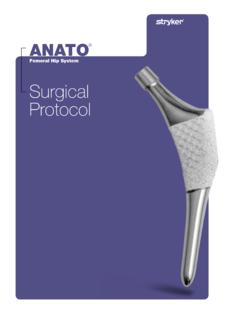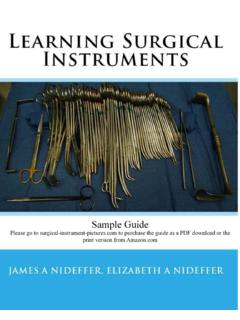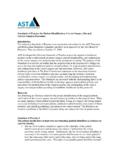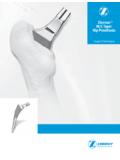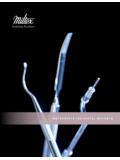Transcription of Orthopaedics GMRS Distal Femoral Surgical …
1 OrthopaedicsGMRS Distal FemoralSurgical ProtocolGlobal Modular Replacement SystemAcknowledgementsStryker would like to thank the following surgeons for their contributions in devel-oping the Global Modular Replacement System ( gmrs ).Jeffery Eckardt, Kotz, Malawer, Mercuri, would also like to thank the following surgeons for their input in reviewing this Surgical Hornicek, Menendez, Lackman, Sim, Thomas Temple, Distal Femoral components are marketed in the United States for use with bone Distal FemoralSurgical ProtocolTable of ContentsIntroduction 2 Description of the Distal Femoral Global Modular Replacement System 4 Indications/Contraindications 6 Surgical protocol 7 Measuring Resection Length 8 Rotational Alignment 9 Femoral Osteotomy 10 Preparation of the Femur 11 Proximal Tibial Resection 12 Tibial Preparation for the Modular Rotating Hinge (MRH)
2 Tibial Baseplate 13 Establishing the depth of the tibial cut 14 Proximal Tibial Resection 15 Femoral and Tibial Trial Assembly 17 Trial Reduction 18 Assembly of the Tibial Stem Implant 20 Titanium Tri-Fluted Stem Option 20 Assembly of the Femoral Prosthesis 21 Implantation and Orientation of the Tibial and Femoral Prosthesis 23 Final Implant Assembly 24 AppendicesAppendix I Establishing the Depth of the Tibial Cut Option A: Femoral Referencing Method 28 Option B: Extra-Medullary Referencing 30 Option C: Intra-Medullary Referencing 34 Appendix II Tibial Preparation for the All-Poly Tibial Component 40 Appendix III Taper Disassembly 46 Implant Listing and Resection Length Overview Chart 48, 491 gmrs Distal Femoral components are marketed in the United States for use with bone cement.
3 2 GMRSD istal Femoral Surgical ProtocolIntroductionThe gmrs Distal Femoral Components are based on over a quarter of a century of clinical history. Patella kinematics have been enhanced by incorporating a deepened patellar track to articulate with the Duracon patellae. The gmrs standard Distal Femur accepts the Modular Rotating Hinge (MRH) Tibial Bearing Component, Bushings, Axle and Bumper for seamless integration with the MRH resurfacing Tibial Stem options for the gmrs Distal Femoral Replacement are unrivaled and now offer six cemented stem options: straight, curved and long curved; each type with or without extra-cortical porous-coated body Femoral Surgical ProtocolStem ComponentsCemented StemsThe gmrs cemented stems are available in six styles: straight, curved and long curved; each style with or without extra-cortical porous-coated body sections.
4 The extra-cortical porous-coated body section has a 40mm replacement length. The stems are also available without the extra-cortical porous-coated body section, with an 11mm replacement of the Distal Femoral Modular Replacement SystemThe gmrs System was developed to meet the unique needs of patients who require reconstruction of large segmental defects for tumors, failed previous arthroplasty, or trauma. This system is designed to: Reconstruct large segmental defects of the knee Reconstruct osteoarticular defects of varying sizes Allow for variation and intra-operative changes of the Surgical system consists of Distal Femoral components, extension pieces and stems.
5 It also includes a complete set of trial components and modular implants are assembled by impacting a male/female taper design, securely locking them Femoral ComponentsThe Distal Femoral components are available in two sizes, small and standard, and both are available in left and right configurations. The standard size Distal Femoral component measures 60mm in the M/L and 54mm in the A/P. The small size Distal Femoral component measures 52mm in the M/L and 45mm in the A/P. Both sizes have a 65mm replacement length. All Distal Femoral components have a built-in 6 Valgus offset and utilize the Modular Rotating Hinge (MRH) Knee components.
6 NOTE: The small Distal Femoral component uses dedicated small bushings and a small ComponentsAll stems are available in 8mm, 9mm, 10mm, 11mm, 13mm, 15mm and 17mm diameters. Their respective seat diameters at the resection level are as follows:The stems are designed to be cemented into the medullary canal. Optional stem centralizers are available for the 10-17mm diameter (for the straight and short-curved stems only). NOTE: The small cemented stems (8mm, 9mm and 10mm diameters) are intended to be used with the small Distal Femoral component. Stem Diameter Seat Diameter 8, 9mm 22mm 10,11mm 24mm 13mm 28mm 15mm 32mm 17mm 36mm5 Tibial ComponentsAll-Polyethylene Tibial ComponentThe All-Poly Tibial Component is available in five sizes (XS,S,M,L,XL), each in 4 thicknesses (8mm, 11mm, 16mm and 21mm).
7 The component is designed to accept the long All-Poly Tibial Bearing Component only (6481-2-103). NOTE: The All-Poly Tibial Component is intended for use when it can be adequately supported by cortical bone around its Rotating Hinge Tibial BaseplateIf the bone quality is suspect or the component cannot be properly supported, the Modular Rotating Hinge (MRH) tibial baseplate is MRH Tibial Baseplate is available in four sizes (Small 1, Small 2, Medium 2 and Large 2), with modular stem options (80mm and 155mm lengths, 10-23mm diameter).The tibial inserts are available in two sizes (Small 1 / Small 2 and Medium 2 / Large 2), each in 5 thicknesses (10mm, 13mm, 16mm, 20mm and 24mm).
8 The MRH Tibial Baseplate is designed to accept the MRH Tibial Bearing Component only (6481-2-100). A comprehensive range of modular stems are available to be assembled with these Tibial ComponentsThe implant system is complemented with a complete set of trial components. The trial components are replicas of their corresponding implants; however, they have non-locking trunnions. The trials are satin-finished and have no coatings, so that they can easily be distinguished from the implants. A 30mm Trial Extension Piece also functions as the Trial Extra-Cortical Body. Together with the Trial Cemented Stem, it forms the Trial Stem with extra-cortical porous-coated PieceMRH Tibial BaseplateAll Poly Tibial ComponentExtension PiecesThe extension pieces are used to customize the replacement length and are available in 30mm, 40mm, 50mm, 60mm, 70mm, 80mm, 100mm, 120mm, 140mm, 160mm, 180mm, 200mm and 220mm lengths.
9 This component features a male and female taper, which attaches a stem to a Distal Femoral Femoral Surgical ProtocolIndicationsThe Modular Replacement Systems are intended for use in patients requiring extensive reconstruction of the hip joint and/or knee joint, including knee fusions, necessitated by extensive bone loss due to trauma, failed previous prosthesis and/or tumor As related to Bone Tumors:Not all bone tumors may be treated successfully by segmental resection. Any condition that may have already resulted in either local or distant spread of the tumor may be a contraindication. Examples of such conditions include: Pathological fracture; Overt infection; Inopportune placement of biopsy incision; and, Rapid disease progression beyond a respectable patient must therefore be individualized and carefully evaluated by appropriate staging techniques prior to consideration of segmental As related to Failed Previous Prosthesis and Trauma: Any active or suspected latent infection in or about the operative joint.
10 Any mental or neuromuscular disorder which would create an unacceptable risk of prosthesis instability, prosthesis fixation failure, or complication in postoperative care. Bone stock compromised by disease, infection, or prior implantation, which cannot provide adequate support and fixation of the prosthesis. HA coated stems are contraindicated in situations where bone stock is inadequate to support press fit package insert for warnings, precautions, adverse effects, information for patients and other essential product using gmrs instrumentation, verify: Instruments have been properly disassembled prior to cleaning and sterilization; Instruments have been properly assembled post-sterilization; Instruments have maintained design integrity.





